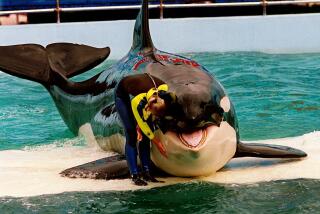SeaWorld trainers now tend killer whale from a distance
- Share via
Reporting from Orlando, Fla. — Three times a day, SeaWorld Orlando’s killer whale trainers brush Tilikum’s teeth, just as they always have. But they no longer stand right next to him with a water pick. Instead, they use a 2-foot extension so they can work farther from the 6-ton orca’s jaws.
The jury-rigged toothbrush is one of the many adjustments SeaWorld has made in the weeks since Tilikum grabbed veteran trainer Dawn Brancheau by her ponytail and drowned her in front of park guests.
After the Feb. 24 tragedy, SeaWorld removed Tilikum from daily shows and ordered trainers to keep their distance from the animal, who is twice as big as any other orca at the park. SeaWorld imposed the restrictions while it reviews its killer whale safety protocols, a process expected to extend into April.
Although Tilikum no longer shows up to splash audiences during SeaWorld’s popular “Believe” killer whale show, he continues to live in the park’s seven-tank orca complex. SeaWorld says it has taken numerous steps to continue providing healthy surroundings for him.
“He’s the same exact Tilikum through all of this, and we’re providing him with the same exact environment, as far as it being stimulating and enriching and healthy,” said Kelly Flaherty Clark, curator of animal training at SeaWorld Orlando. “What’s changed is we’re challenged with finding new ways of doing that.”
Some of the adjustments have required Tilikum to learn new behaviors.
Consider how SeaWorld obtains blood samples from its orcas. Typically, trainers have a killer whale line up along a shallow ledge while one trainer kneels by its tail. The animal will then roll over, deposit a tail fluke in the trainer’s lap and allow an adjacent veterinarian to take a blood sample.
But with trainers no longer allowed that close to Tilikum, they have trained him to line up with the tip of a target pole held over the water, with only his tail by the side of the tank. A vet can then reach over a wall to get a sample of Tilikum’s blood.
Flaherty Clark said Tilikum learned the procedure in about two weeks, a sign that the orca remains engaged.
There are other examples. When trainers must open or close a gate between tanks, for instance, they have any nearby orca wait a short distance away, allowing the trainers enough time to adjust the gates.
Tilikum used to maintain such holds for only 10 to 12 seconds, Flaherty Clark said; now, he holds for as much as three or four minutes.
Tilikum has even learned a new way to accomplish the orca equivalent of cleaning his room. Whenever he is done playing with his “toys” -- which include oversized plastic disks, blocks of ice and large balls originally designed for elephants -- he deposits them by the side of the pool and then swims to another tank so trainers can enter to gather them.
Flaherty Clark said Tilikum had long enjoyed tactile interactions with his trainers -- having his pectoral fin rubbed, for instance -- that are no longer possible. So trainers now spray saltwater from a high-pressure hose into his tank to simulate a massage.
“You’ll see him manipulate his body in ways that only he can possibly come up with, in order to get just the right body part under the saltwater pressure,” Flaherty Clark said.
Tilikum continues to rehearse maneuvers used in SeaWorld performances, to keep him active and alert.
Although SeaWorld maintains that life remains enriching for Tilikum, some animal activists who argue against keeping killer whales in captivity say that is unlikely.
Howard Garrett, board president of the Orca Network in Greenbank, Wash., said forcing trainers to keep their distance probably has a negative effect on Tilikum, as orcas are inherently social animals who enjoy physical contact.
“They’re very tactile. . . . He’s going to notice the difference that nobody will come close to him,” Garrett said. “And, inevitably, that’s going to increase his sense of isolation.”
SeaWorld has said it will not permit its trainers into the water with any of its killer whales until after its safety review is complete.
But the park is determined to take care of Tilikum. Flaherty Clark said trainers began thinking of new ways to care for him immediately after the accident.
“Caring for Tilikum is something that was absolutely front in our minds,” she said. “It would certainly have been at the front of Dawn’s mind.”
jrgarcia@ orlandosentinel.com
More to Read
Sign up for The Wild
We’ll help you find the best places to hike, bike and run, as well as the perfect silent spots for meditation and yoga.
You may occasionally receive promotional content from the Los Angeles Times.






